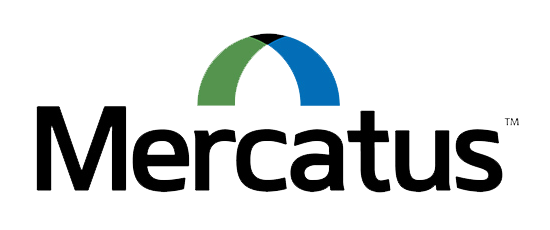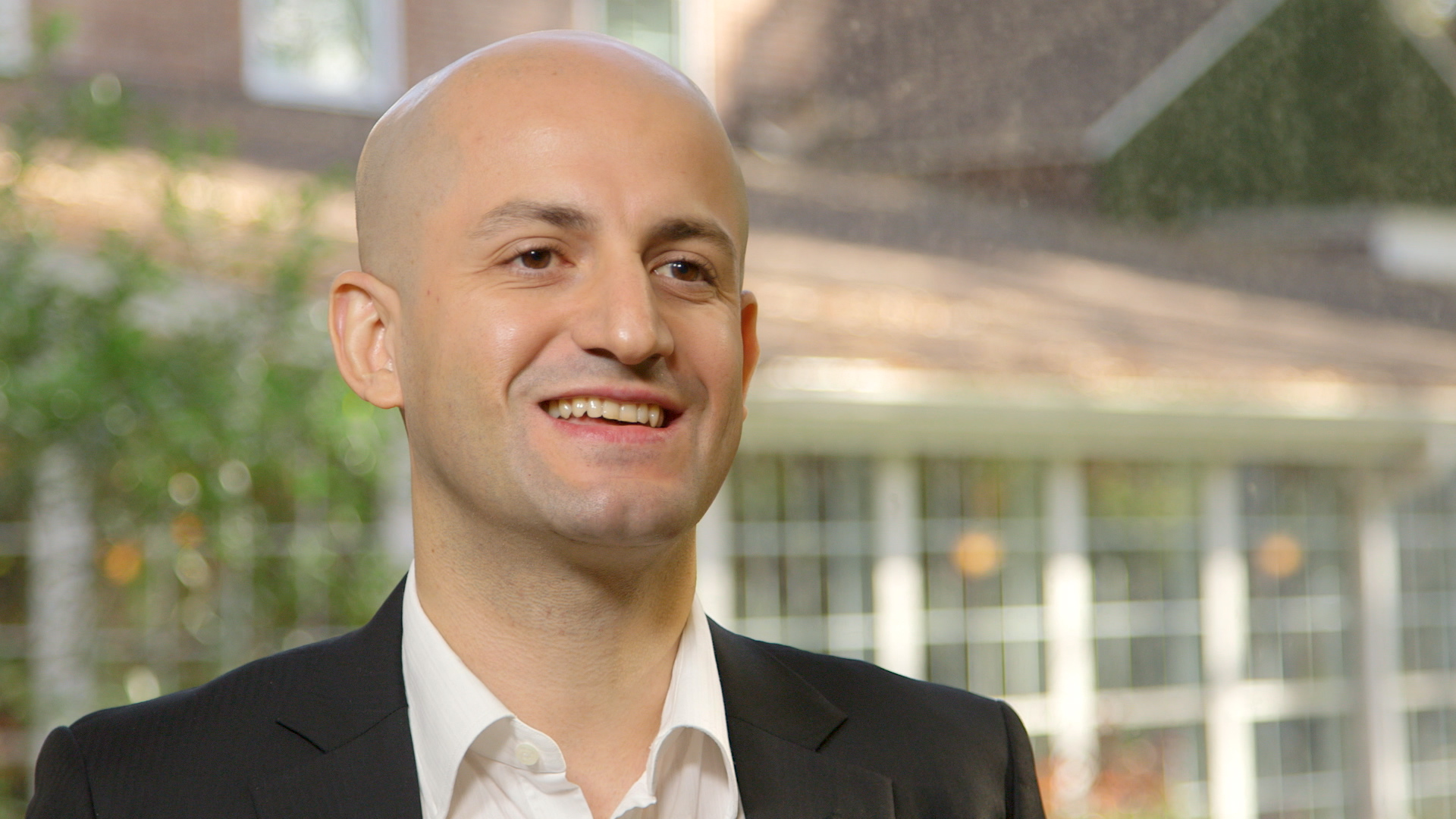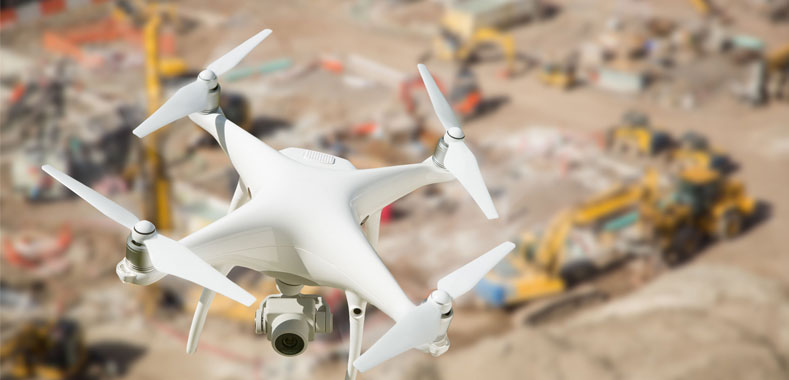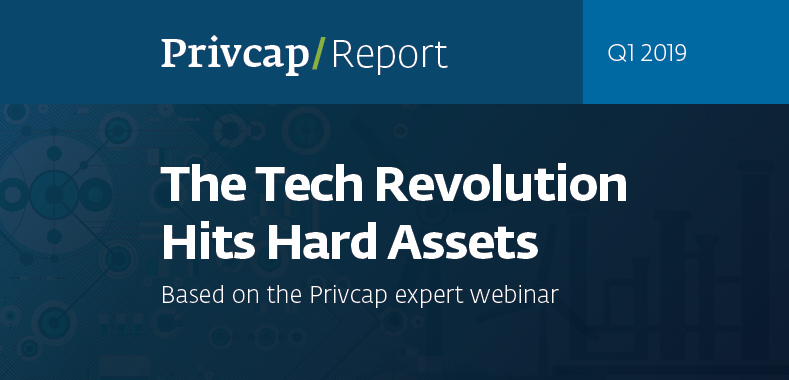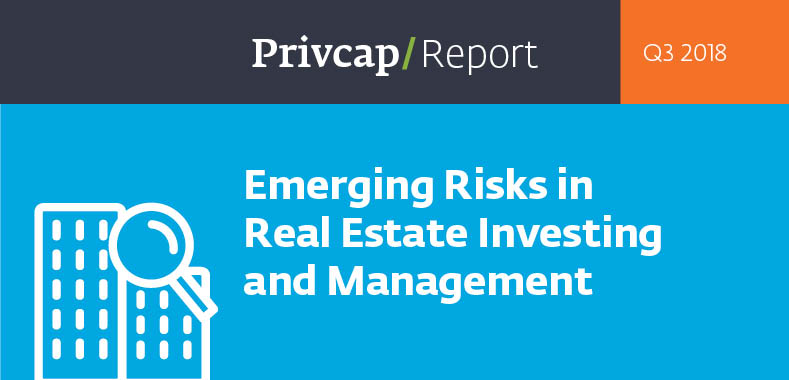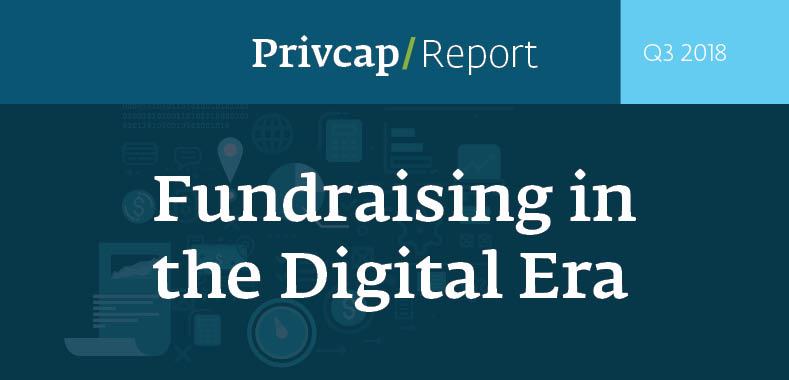On-Demand Webinar: The Tech Revolution Hits Hard Assets
Institutional investors have poured trillions into investment strategies termed variously real assets, infrastructure, hard assets, because of the perceived downside protection, non-cyclicality and predictable cash flow. Thanks to rising technologies and new business practices, these underlying assets can now be better assessed, monitored and optimized. What does this mean for the investment opportunity going forward?
Transcript Download Transcript
On-Demand Webinar: The Tech Revolution Hits Hard Assets
David Snow, Privcap:
Hello and welcome to a Privcap Webinar. My name is David Snow, I’m founder and CEO of Privcap, and today we’ve got a very exciting topic for you: It’s all about the application of new technology to hard assets, infrastructure and other kinds of assets that are very attractive and increasingly attractive to institutional investors, and yet on top of that we have all these new technologies such as artificial intelligence, and data science, and even drones, that are being applied to these assets and sort of changing the investment outlook for them in exciting ways.
Before we begin, I’d like to ask our three experts to briefly introduce themselves, and let’s start with Brandon from KKR.
Brandon Freiman, KKR:
Hi good morning, thanks David, great to be with you all. Just my background, I’m a partner at KKR and lead our North America infrastructure team. I’ve been with the firm for about 12 years, from joining on the private equity side, this is before we really had an infrastructure platform and part of the infrastructure business we’ve been building really since its inception so, great to be with you all.
Snow: Great and now Dana Sands from Energy Infrastructure partners.
Dana Sands, Energy Infrastructure Partners:
Hi, I’m Dana Sands from Energy Infrastructure Partners. We’re a small investment bank that focuses on energy and infrastructure. I come to this from not only the investment banking perspective, but also the investing perspective and the perspective of a CFO. I was with Alinda Capital, one of the first employees, when we raised three billion dollars and invested it and raised a second fund of four billion dollars and invested that as well. But I also have direct experience on the side of the CFO working at a green energy company for about four years and I started at Morgan Stanley and investment banking and now in investment banking again.
Snow: Great, and can we hear please from Tim Buchner, from Mercatus?
Tim Buchner, Mercatus:
Hi, this is Tim Buchner, I’m the co-founder and COO of Mercatus. We’re a ten year old software company born out of being an investment bank and growing into a software company, to really solve our own challenges. We started our company ten years ago, and over the last ten years have really grown from supporting organization like funds and large asset managers, from about all the renewable assets classes, all the way through to large infrastructure, and so today we have about 450 billion dollars that are managed on our platform across 110 countries.
Snow: Great, well, let me just make some brief opening comments about this webinar: It is designed to be interactive, you the audience will have the opportunity to send questions in and we’ll certainly try to get to all the best questions that we can. Typically, we will address questions in the final ten to 15 minutes of the webinar but if something comes in that’s especially relevant we might pause to answer it.
So why don’t we start with a question for Brandon: Brandon, you’ve been investing in all kinds of infrastructure and hard assets for a while, as you think across the many different forms of technology whether again it’s data science, artificial intelligence, machine learning, even drones, talk about the impact that these new technologies will have on the investment opportunity across infrastructure.
Freiman: Sure. As we were looking at the impact of technology on all these various sectors, a number of years ago all the partners at the firm got together and we realized that we have a lot of technology content in depth at the firm, but it all really sat within our technology private equity group, and of course the reality is that all these technology trends cut across everything we do as a firm, whether it’s in industrials or consumer products, and of course infrastructure.
And of course within infrastructure, if you look at the three largest sectors that we tend to focus on within in KKR, there’s a wide range of sectors but the ones that yield the most reliable and recurring deal flow are midstream power, and utilities, and communications infrastructure. And each one of those is really susceptible to disruption from these technologies, whether it’s on the midstream side clearly the shift towards renewables could have long–term implications on demand for hydrocarbons, on the power and utilities side, clearly the battery technology, but also demand side management, both could have pretty dramatic and long term implications on the whole architecture of the grid, and of course on the communications side here in many ways, that’s really at the tip of the spear and as you look at, there are a lot of 5G and its successor. That can have dramatic implications on various different parts of the value chain, whether it’s data centers or towers and so on, and as we reflect on it, there’s probably, the only sector I can think about with an infrastructure that feels pretty immune from disruption is water utilities.
We don’t have any better ideas than pipes leading into residential homes, delivering water for how that ought to evolve, so that seems pretty safe. But it seems like all these sectors are very susceptible to disruption, and having all of our technology content adapt and reside in on our technology project, didn’t make a lot of sense. We really created this innovation team that really cuts across the entire firm a number of years ago, to really help all of our investment teams think about how to get ahead of these disruptive trends, and to really think probabilistically about them, because I think when you look at all these trends, again maybe putting water utilities aside, you can sort of talk yourself out of doing anything because everything is to some degree susceptible to disruption. But I think having this team that’s able to help us take a fresh look at all of these trends, and for a view around timing and probability, has allowed us to be a bit more thoughtful around which trends we lean into, which one’s give us real pause today, and we can talk about obviously about specific examples around that, around the various sectors we talked about.
Snow: Great, maybe next question for Tim, as someone who oversees a platform with just a ton of information about real assets, how are you seeing asset owners and asset managers increasingly use data as they try to add value to these assets?
Buchner: Thanks for the question. so, as starting point, since we started the company, just looking across infra, we’ve seen roughly eight trillion dollars go into the space, and as that’s grown, we’ve really grown from supporting a single asset class to over 12 today, and we’ve just seen tremendous variance, and how investors and operators really look across energy infra, and how they manage and utilize data across, you know, we’ll call from decisions to strategies, investments, and just even the mere everyday workflow, and for some of the better run companies, we’ve just seen a huge influx of the investments that they’re making and sort of even the corresponding applications utilizing data intelligence and science, and so when I think about examples that have been sort of most exciting and sort of groundbreaking, maybe as a starting point, just, what’s become table stakes and almost boring—which is exciting, even here—is that even in just power generation alone, operators are really driving now, close to real time data feeds to all their assets, and it’s all about maximizing performance, and minimizing OPEX [Operating Expenditure] and I think primarily, that’s been driven just because more and more requirements have been around hitting returns, and maximizing returns and it’s been all about reducing margin compression, that it has really driven, “How do I made sure operational assets are more and more optimized?”, and what’s interesting about that is that I call that baseline, but what’s exciting in the innovations we’ve seen is how sort of that technical data has been merged with financial data and that then the two kind of coming together in perfect storms. Where there’s this emergence of dynamic pricing that’s happening in infra. So if you just use electric vehicles as an example where some of the companies that work within our platform, they’re the leading companies which sort of are looking for real time adjustments to charges and looking at that for sort of a variety of different reasons.
So they’re looking at it from when customers are willing to pay the value they place on that service, balanced against the urgency of that usage, and so what’s interesting is that technology has to meet, we’ll call it the operational characteristics of these assets, and it’s not so easy in a lot of these organizations that really haven’t looked at data as their essential—
Snow: Maybe a question back to you Brandon: Can you give a specific example of an investment that you’ve made where a specific form of technology has sort of made it an exciting operational difference, or you expect it to make an exciting operational difference?
Freiman: Sure yeah I’m happy to give one or two, and maybe to step back a little bit, I know we’re talking here about AI and machine learning and so on, I think there are some fairly narrow areas where we’ve been able to leverage that in infrastructure to some extent, more on the operational side, I’d say broadly within the firm, you certainly see more of that in areas like consumer products where you can use machine learning to sort of spot trends before the sales data validates it. But within infrastructure, I think what we found is that the real opportunity is that you look at a lot of these industrial businesses and in many ways they’re really built on a 1980s and 1990s software architecture.
Snow: That’s right.
Freiman: And we see this really, it cuts across every sector we look at, and so in the same way that we have our technology specialists, you know, five years ago, we were all sitting with our technology team and we tried to create this capability at the firm level. If you look at where just broadly within the economy, where the top engineers and technologists go, they’re going to technology companies. They’re not going to parking business and to waste management business and so on, and so I think what we found is that, leveraging through our operational team at Capstone, which is our operational improvement team and outside parties. We’re able to go and, while we’re not deploying AI and machine learning to sort of get all these reams of data, and plug it into a machine and spit out an answer, we found that we’re able to deploy 21st century technology and software architecture to drive pretty dramatic performance improvement.
So just to pick an example, we own a parking business in Europe, and we could talk about the longterm disruption trends that that business could be susceptible to and how we got comfortable with that, but if you think about what a parking business does, it manages an inventory of parking spaces. The historical approach to that is you set a price and you get what you get from a revenue perspective, and that’s really been the 1980s and 1990s architecture of pricing and revenue management, that most parking businesses deploy, particularly since they were all pretty fragmented and at small scale, and if you can deploy a revenue management system that really looks at your historical data, understand the trends and time of day and areas for revenue optimization, you can introduce whether it’s time of day pricing, or other features to really optimize pricing and revenue without any real capital deployment.
So, that’s not a machine learning or an AI type of functionality, and maybe those tools in the future will lead to something that dramatically changes the game again, but what we’ve found that just running a playbook of just leveraging the best 21st century technology out there can really lead to pretty interesting operational improvement opportunities.
Sands: Can you guys hear me now?
Snow: Yes Dana, you sound great.
Sands: I just want to jump in there on parking as well. I just think that’s one of the great P3 opportunities for investors. There’s so much that can be done to maximize revenue and to minimize costs, almost every part of the parking chain can be autotomized, whether it’s parking enforcement, now a van can just drive down the street and start issuing tickets automatically to parking collection, it’s all done by the data driven right now to optimizing again, the revenue. I mean I’ve worked on one really, really large parking transaction where the city refused to let the investors do dynamic pricing, or lower the prices, there was a minimum price that we always had to charge and the city didn’t realize anything about elasticity of demand and how to maximize revenue. I think that people have learned a lot since that transaction got done, both in the on street and off street parking, it’s about sensors, it’s about wireless communication, for off street parking, it’s about increasing the number of cars that can be put into the same amount of space.
You can completely automatize garage parking, you can fit three to four times the number of cars than you otherwise would, and it’s much faster than going to get your car. There’s a garage in Boulder, Colorado that is completely automated. It’s got a parking robot; they guarantee delivery of your car in three to four minutes without any human interaction at all; they use lasers and sensors. It’s just a very, very interesting area and I also just wanted to make one comment about water: Even the utilizers do have access to more interesting water services companies that can better detect leaks, there’s all kinds of technology improvement there, and we see across the broader definition of water, waste water, smart wastewater facilities are now using anaerobic digestion to power their own facilities. So in Hartford, Connecticut they’re completely off the grid with really innovated anaerobic digestion that takes the gas from waste water and turns it into electricity that runs the plant.
When I was at Alinda, we worked on the first water recycling facility in the country, that was owned by a municipality. So I think there’s just a lot of opportunities using water and desalination, and the more waters used in fracking, the more near and dear it is. I really am very bullish on different water technologies.
Freiman: While I sort of minimized the role of machine learning and big data, day to day, I think one of the areas within infrastructure where we definitely have seen that been relevant is, when you think about pipelines, whether it’s on the water side or on the energy side—so oil or gas—You’ve really got thousands of miles of flows and data collection at various intervals along those lines, and one of the areas where we have seen machine learning be quite relevant, is really around leak detection and predicting when you’re going to have operational issues, and then you’re just given the amount of data to be able to mine that data and forecast when you’re going to have an issue and go get at it before it happens, I think that has been one application we’ve seen, it’s actually pretty significant when you think about just the overall operational risk, safety risk and efficiency of these kinds of assets.
Buchner: I kind of have a question and a response kind of packed into one for both of you guys, because I think that as we’ve been talking about parking and we’ve been talking about sort of different energy type assets, one thing from an investor perspective given we’ve got a lot of GP’s on the phone, and we’ve got a lot of private equity investors on the phone, I’m interested in just the evolution of sort of asset–level investing and the growing need of, as you have complexity and you have diversity of all these assets that are out there, parking being a great example.
How much are you treating every investment as sort of it’s own P&L, and when you are treating it as its own P&L and you talk about data management Brandon, how are you seeing that evolve within KKR, within partnership companies? I’ve got a response too but I’m just interested in your view.
Freiman: I mean, look, the way we came at infrastructure is really from our private equity mindset, having been in the private equity business since the 70s, and so, our approach is really to take our private equity toolkit and deploy that in companies that own infrastructure assets. So we haven’t, if you look at our investment track record, it’s been less about buying a toll road here, and an individual asset there, and more around acquiring building or partnering with companies to go build business in infrastructure sectors, the predominant ones being power and utilities, midstream and communications. But it cuts across as number of other sectors, and so the way for us, that really starts and ends with partnering with the best management teams and the best companies in those areas.
But then, we really leverage what we’ve done in private equity for a long time, which is to supplement that with our internal operational capability, which we’ve since sort of broadened to really encompass this innovation area, to help our companies get ahead of some of these trends. So if we own a communications company, working with them to think about what does the deployment of 5G mean for the various different parts of the value chain within communications? How should we think about the risk that poses to data centers versus fiber versus towers, and you can come up with analogous examples across all the other industries you cover.
Sands: Yeah, I think that when the difficulty of achieving the returns of an investor, or trying to in infrastructure and the proclivity of low returns in infrastructure, you really can’t invest in an infrastructure asset that you don’t think can improve the returns. So if the firm are just going to invest in an asset that sits there, that you cannot improve the returns, it’s not an investment any of today’s infrastructure investors would make.
At Alinda it was all about, we had more people dealing with improving the returns on the assets than in going to find new assets to invest in.
Buchner: Yeah just to bridge the two discussions because I think it’s actually a really interesting discussion sort of like private equity on one side who invest with portfolio companies and sort of asset level investors, or portfolio level investors on the other. A growing trend that we see is that private equity firms are trying to help support digital strategies and they could be machine learning or even just helping portfolio companies just get the basics of centralizing that data across all of the different disparate asset classes to be able to do the level of analysis they should be doing at sort of the portfolio level company.
Buchner: Even in organizations that are moving sort of out of private equity and moving into much more direct investing, what we’re finding is that, as they’re making or raising their first infrastructure fund, maybe they’re on their third or fourth, they’re looking at those assets of, you know, how do I optimize those? And gosh, the level of complexity—because there’s a lot of diversity now, maybe they’re doing toll roads on one side, they’re doing bridges on another and then they’re doing energy on another. It creates a world of complexity that I think organizations are now hitting a level of, we’ll call it complexity curve and level that they have to do something about it.
So what we’re finding at least, is that the organizations definitely are trying to look at optimizing but also making sure that they’re actually hitting the returns that they’re saying, both at the asset level and the company level, so we’re seeing a huge trend there.
Snow: I do have a question for all of you regarding due diligence, but before we go there, Dana you did mention in our planning call, having some really interested insight about bridges as assets and the use of drones. Can you tell us about that, because it sounds very futuristic.
Sands: Yeah, it’s a faster, it’s cheaper and it’s safer so to inspect bridges, very few humans are now climbing up on the rigging, it’s all done by drones and it’s much cheaper and safer. And the other thing I think that really changed bridges is transponders, and again it’s sort of like parking and real time revenue generation. I know one bridge owner that sends out emails for discounts over the weekend because they want to get the traffic up over weekends, because a lot of the traffic on this particular bridge is work related, and it’s been able to increase their revenue by five to ten percent, just by using real time pricing, in something as simple as email.
But drones can be used in many different types of inspections, and many different assets, but bridges in particular since they’re so high and dangerous, it saved lives the investor says.
Snow: I also know that, I don’t know if any of you invest in energy infrastructure, but I do know that drones are being increasingly used I believe in pipelines and in oil fields. It’s just an easier way to get to some of these assets that are in far flung locations.
Sands: Mhm.
Snow: Great, well, and here’s a question for all three of you which is, you know, there’s optimizing the assets, using new technologies, but then there’s betting and performing due diligence while you’re trying to, or thinking about, underwriting the asset. And I’m wondering, what we think there are by way of advances in technology or data science, that allows you to understand the assets that you may invest in during the due diligence phase, I may be throwing the first question over to Brandon.
Freiman: Yeah so look, I think what we like I said, we don’t yet have a sort of a supercomputer where we just feed in a bunch of data from social media and other sort of crawling the web, that culminates with it spitting out an answer and what’s going to happen. We may get there but we’re certainly not there yet, but we do do is, really pull in other folks at KKR that have a point of view and who can help us understand, the key question that frames up the disruption risk. So for instance, I could give you a couple examples: We looked at a waste management company a couple years ago that had both landfills but also a collections business.
And I think as we looked at the nature of the collections business, which you know, talking about 1980s, 1990s architecture, if you look at the root management, and the dispatch profile of how these waste collections businesses are run, they haven’t changed much over a long time, and yet there’s so much data there to be mined around how to optimize that root management, and now the ability to actually have sort of a feedback loop so that the customer can actually buy waste collection on demand, and it’s almost sort of the uberification of the collections business. And that could be quite disruptive, if you think about a business where the legacy is that you make a stop along the route every day or every two days, or whatever the typical schedule is to something that’s more on–demand.
And I think having the capability to understand as best as we can, how those trends can impact these businesses is game changing, but I go back to the prior point, which is you can sort of talk yourself out of any of these sectors, when you look at the risk over the next 10, 20, 30 years, and the reality is if you look at where multiples are today, if you’re paying a multiple, you know well above ten times, you do have to have a point of view around what the worlds going to look like 10, 15, 20 years from now, because you’re paying for cash flows out well into the future, and I think what we’ve tried to do is really think probabilistically around all these trends, frame out which ones seem more likely and which ones seem more distant.
Not just timing–wise, but probability–wise, and it’s okay for the answer to some of the questions to be, “I don’t know,” you just then need to reflect that in your thinking around the range of outcomes and how much risk you want to take on around that.
Sands: I can name the three different areas where technology has helped improve the due diligence process and just, really briefly in wind, data from Met towers, and solar stuff like the insulation statistics, PV systems is something as simple as that, and traffic studies, where you can have a much more comprehensive traffic study, because people aren’t out there counting cars anymore, they’re using sensors, any technology that decreases risks for investors is just great for the industry.
Buchner: Maybe one additional part—because I don’t want to add to what other people have said other than say that—you know, if I think of internal organizations, like organizations that are customers of ours, and companies that we’ve seen actually have best practices around how to drive repeatable due diligence is that, I think a lot of the industry there’s one hidden problem, is that most of it is run out of Excel, and as a result of most of it being run out of Excel, very few organizations actually think of, “Well how do I extract the very best value out of Excel and leverage it as the best engine in the world, and model all these kinds of risks and returns, but also how do I extract every nuance, every change that ever has been happening, so I can actually use that learning as a way to actually say well, what did I say in my investment thesis in committee number one and what did I actually underwrite to and what did I actually see in operation two to three years later or 20 years later.”
And if I think of due diligence innovations, some of our largest customers have actually created real strong investment processes across their life cycle, where they’ve actually thought about the engine from start to finish, and used the power of Excel but also used the power of extracting from Excel into an actual database to really leverage that data, to then actually compare front to back, and I think that in order for us to have the innovations around continuing to save every last basis point you possibly can in this market, we’ve seen as much as, 300 basis points lost from that start to finish, beginning to end, and as a result of that, that’s a whole lot of profit to gain back, and so I think in due diligence to actually think about how data’s managed in and out of Excel is a real important innovation for the people on the calls for sure.
Snow: Well I’d like to get some questions from the audience, we do have few good ones that I think we should address, but maybe just one more quick topic because it’s so interesting and maybe we could start with Dana. There are investable water assets out there that are being profoundly affected by some of these technologies, can you talk about a few of those investment opportunities?
Sands: Yeah I think I’ve mentioned briefly, one of the areas that I think is really, really interesting is waste water, you know the fact that there’s such a dearth of water in so many different areas, people are getting smarter and smarter on how to deal with it, whether it’s produce water from fracking, whether it’s water that’s salty in wester Texas that needs to be desalinization, whether it’s creating energy from your waste water treatment plans and anaerobic digestion, they’re all opportunities that I think are really front and center for infrastructure investors. I mean, there’s other areas of water that are a little bit farther out there, I was looking at a company the other day that actually uses salt water to irrigate plants and trees, because the tubes that they use transport only the water vapor, not the saline, and are using it to water citrus groves in Florida with saltwater.
I think in hydropower—these things also are on the cutting edge—but, they’re actually testing a vehicle to use, hydro powered vehicles that use water to power the engine, I just think there’s so many different mobile recycling facilities for water to be used. It’s really, really endless and I think it’s almost more waste water opportunities and desalinization opportunities, than water itself.
Snow: Well why don’t we go to a question from the audience, we’ve got about 15 minutes left, and we’d love to get some good questions in. There’s a question about recessions and cyclicality of infrastructure assets. Can you talk about the impact whether technology makes some of these assets more prone to recessions or less prone to recessions and what do you think might move the needle, maybe starting with Brandon?
Freiman: I think most of the sectors we focus on do have some susceptibility to the economic cycle, certainly anything along the energy value chain, to de-sanitize any volume risk is susceptible to midstream, and power as well if you’re susceptible to demand. I think on the communications side, there’s clear susceptibility there, particularly for serving enterprise customers, and so look I don’t think technology has all the answers around these questions, it certainly doesn’t make the business models more immune to the economic cycle, but I think it probably does help to some extent, and again I think is more deploying sort of 21st century technology versus the bleeding edge of AI and machine learning, at least today.
But I think it can help us understand the implications of where we are in the economic cycle a little bit better, it’s amazing when you think about all the sophisticated tools that we have, and yet many times when we’re talking about these questions around the economic cycle, we’re very crudely comparing back to what it looked like during the financial crisis mode, what is the worst case look like, and what did recessions earlier in the 2000s look like, and I think having more data and the ability to parse that out allows us to be a bit more informed around what does the next cycle likely look like?
Buchner: Personally, I really like your analysis just at the end there, Brandon, because I think that so many of the companies we work with are trying to have to look far out and really run sensitivities and forecast challenges and whether it’s market fluctuations, whether it happens to be recessions, et cetera, I mean part of the job of the CEO and CFO of these organizations is to ensure that they’re constantly looking and doing what ifs, and if I think of the bigger challenge that we’ve found and you think about sort of what happens when—probably not if— when we do get hit with a recession you know, what will organizations have to do? Well, they can no longer proportionally add the same level of headcount that they used to, to proportionally do all the things that they’re doing today and all the stuff we’ve been talking about today.
Everybody is going to look at tightening their belt, and some organizations will say, “Well gosh I got ahead of that curve, and looked to automation, looked to centralization, looked to be data–led,” and other organizations are going to be caught with their hands not ready to do anything, so I think one of the nice things about the discussion or even question, is just to make sure that organizations on this call really are thinking about what if–ing their business and how they’re getting prepared for it.
Sands: I think that one of the real fallacies of infrastructure funds, in the beginning, when the first infrastructure funds were raised, with all of that, we are recession proof or nearly recession proof. You know many infrastructure funds were raised as a hedge, against recession but we’ve been through the cycle and it’s absolutely not true. Almost no asset is recession proof.
We have a question here about electric mobility projects, I guess this refers to charging stations for electric vehicles: How is that type of asset shaping up as an investable opportunity, has anyone here been involved in an investment of that sort?
Freiman: Sure this is Brandon, I’m happy to jump in. We have actually part of our team based in our office in Menlo Park, California which is in the hub of Silicon Valley and so we feel like we’re able to stay pretty close to some of these trends around new technologies and we’ve definitely have been thinking about charging stations and the electrification of the fleet, that’s going to be a huge source of—there’s going to be need for a lot of capital that employ those facilities, really across the whole landscape in the U.S.
I think there’s really two challenges there around charging stations that make it not actionable at–scale today for us, I think it’s probably actionable at a smaller scale, but it’s certainly something we think we’re going to be spending more time on three, four years out. I think the two challenges are, one, that the technology’s getting up the curve, it’s now more about evolution rather than revolution, but I think once you can get to the point where someone can charge their vehicle when they’re outside the house and not at home, and it take 15, 20 minutes instead of an hour, I think that’s when you’re going to see the adoption increase significantly.
I think the other question that’s just very much up in the air, and this is not so much a technology question as it is a commercial question. Is just what the revenue model’s going to be around these facilities, there’s a full range of commercial models we’ve seen going from sort of advertiser based to the commercial location, whether it’s a Whole Foods or otherwise pays for the facility and they have a couple parking spaces in front of the store and you get to use if it you’re there on a first come first serve, and it’s quote unquote free to subscription based models. So I think the maturation of the industry which will start with the improvement of the technology which I think is inevitable, will I think lead to a bottoming out of which of these revenue models will really last, and I think once you have that then you can start to add ingredients for infrastructure capital coming in, pricing out the revenue model with contracts or with a view on demand, and for infrastructure capital like ours to be a part of the solution there.
Buchner: Maybe just one comment from Tim, just building on what you just described, so we have several companies that are actually building pretty substantial EV fleets, coming out of actually pretty large power producers and we’ll call it other infrastructure investors, and I would say I would equate exactly what you just described as each of these companies are treating each of these EV stations as an asset, as its own investment in it’s own right, and I think if there’s one major trend we’ve seen, it’s that we don’t really know what those business models are, and so as a result these organizations are having to be flexible in number one, how data is coming into their solutions, and how they are able to actually turn on a dime for some markets it’s one business model, other markets it’s another, so how they think about deploying technology and actually reading in information from those EV stations has become paramount.
We have one great example of very fast moving customer that’s based in Italy, and they’re building out one of the largest networks across Italy and across Europe and as they’re doing that, if there’s one thing they’ve said to us many times over is, “The flexibility of our business model is paramount as we continue to grow.”
Snow: Great, well we have a question here about Public Private Partnerships, PPP’s, maybe we can throw that one to Dana, you know Dana are there any particular PPP opportunities that you think the application of some of these new technology’s sort of enhances or makes more viable?
Sands: I think they make them all more viable, certainly parking is I think a win/win situation for cities and there have been several successful P3’s done in the parking area. I think tolls express lanes can also be done quite easily, I think every P3’s a challenge but if you have technology that’s going to help the profitability that’s one area where investors can come in and spend the money to upgrade the pipes, upgrade the technology equipment to get more money out of existing assets. Almost any infrastructure of that class that can be done, I think the difficulty with P3’s is getting them approved, when we were at Alinda, we run the Alligator Alley P3, we were awarded it and then the next day the Governor took it away, it’s just they’re very challenging to do.
Freiman: I would just jump in there— we’ve done a couple of municipal water P3’s in the northeast, I believe it’s still two of the three that have ever been done in the U.S. on the municipal water side, and I definitely agree with Dana’s comment, the answer to more P3’s is not going to lay in technology, there’s a ton of capital on the sidelines that would love to participate in P3’s, so there’s a supply capital, there’s a tremendous demand for capital in the sense that you have a lot of aging infrastructure, whether it’s water or elsewhere.
So I think everything points to the notion that there ought to be a lot more P3’s, I think it’s just the day to day inner workings on various layers of government that make them so challenging, that a lot of people just say, “You know, life’s too short.”
Sands: It’s too hard, yeah, and we did one of the other ones, we did Santa Paula, California which is a wastewater P3 I think it was the first one ever done in the country, and it definitely was wrought with difficulties, but I think waste water is better than water. I don’t think municipalities [00:43:00] want to give their water assets away because they’re afraid of terrorists, honestly that’s what we’re hearing every time, someone could poison the well so to speak.
Snow: It sounds like technology is not going to solve political problems, at least in the near future.
Sands: No.
Snow: Well, we have about one minute left, maybe we could kind of do a speed round here and I’ll ask all three of you, and I know it’s a big questions and I need a short answer, but I’ll ask all three of you what you think are going to be some of the major trends in infrastructure investing, over the next year, what are you excited about or what are you worried about. Let’s start with Brandon.
Freiman: I think macro–wise, you just look at everything we’re seeing in terms of mobile application and the usage of data, and that just seems to bode very well for continued growth and communications infrastructure, and it seems like there’s a lot of runway ahead of that. So it feels in many ways like we’re in the early innings of that. Now valuations are high, and there will be disruption in some of those business models but I think some part of the value chain like fiber for instance, seem in towers, probably more durable and immune from some of that change, you know and the concerns really just to some of the prior comments, multiples are high, and I think having high multiples in the context of business that are in some cases susceptible to disruption, it warrants caution, and it warrants an approach where you really do think probabilistically around some of these risks, and that requires a discerning approach in this environment.
Snow: Dana what are you excited about for 2019?
Sands: Yeah, I was thinking about that as far as new funds are concerned—and I’ve met with several prospective asset managers that are trying to raise smaller funds—I think there’s too much competition among the bigger funds, and a very a limited number of good assets and I think that some of the returns are going to be targeted to be a little bit lower, and I believe that the definition of infrastructure is going to be broadened, so that the investors can become more creative in what they’re doing and try to get a little bit higher a return.
Snow: And Tim, as someone with many, many clients who invest in hard assets, what are you looking at in 2019?
Buchner: As a starting point, as you look at research, roughly about 90 percent of all data and infrastructure and energy hasn’t been sort of even created over the last five years and to me, what really gets exciting is, when you really think about the amount of investment that we’ve averaged roughly in infrastructure, roughly 2 trillion dollars a year, it’s expected to double, and by 2030 we’re talking about roughly 80 trillion dollars of investments being done from now until then, and if you really just think about we’re going to be eight X-ing kinda of where the ten trillion dollars we were two years ago, to eight X-ing that, or even if it’s six X-ing it, that just means that’s that many more investors, that many more complexities, but more importantly that many more assets and portfolio companies out there, and so that means a huge need to do a lot with data and to me, that’s what gets really exciting.
And Brandon, you used a baseball analogy and said you were in the early innings—I’d say we’re in the pregame, where a lot of companies are just,they really need to get prepared for this onslaught of data and this opportunity that’s coming, and as I’ve been traveling a ton in the market, seeing PE companies and real estate firms now coming in to Infra, there’s just a lot of opportunity now and seeing a lot of great opportunity for these organizations to do a lot with the data to come.
Snow: Well, sounds like based on the growth of the asset class, we’re going to be doing a lot more talking about what’s going on with the hard assets in infrastructure, I hope that when we do I can turn to the three of you as experts to present to our audience. For now, we’re going to have to wrap up, but thank you very much to the three of you for sharing your expertise, thanks to Mercatus for being our partner on this webinar and thank you to the audience for listening in.
This webinar will be available in playback mode, it will be available as a podcast on iTunes, and we will be turning it into a report available via Privcap.com. Thank you very much and have a nice day.
Unison: Thank you.




